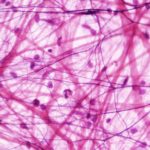Ground substance
The ground substance is an amorphous gel-like material composed of polysaccharide chains (glycosaminoglycans) bound to protein.
With LM, in H & E sections, they are not visible when present in low concentration. However, at higher concentration (as in hyaline cartilage), they stain basophilic. When stained with toluidine blue or crystal violet, they are metachromatic (take a different color than the color of the dye used). The ground substance includes two major groups:
- Non-sulfated glycosaminoglycans (hyaluronic acid)
The hyaluronic acid consists of long molecule that form a network whose spaces are filled with tissue fluid forming gel-like material. The hyaluronic acid predominate in loose connective tissue, vitreous humor, synovial fluid and umbilical cords.
- Sulfated glycosaminoglycans
Chondroitin-4-sulfate and chondroitin-6-sulfate are abundant in cartilage, bone, skin, and cornea.
Dermatan sulfate is found in skin, tendon, ligamentum nuchae, sclera and lung.
Keratan sulfate is present in cartilage, bone and cornea.
Heparan sulfate in arteries and lung.
Heparin in mast cells, in lung, liver and skin.
Functions of the ground substance
The glycosaminoglycans and proteoglycans are highly hydrophilic. The tissue fluid within the meshes permits the diffusion of nutrients and metabolites between the connective tissue cells and circulatory system.
The gel-like nature of the hyaluronic acid is thought to act as a barrier against the spread of bacteria that may enter the tissues. Invasive bacteria produce the enzyme hyaluronidase that facilitates their spread.
Connective Tissue
The CT is a type of tissue designed to connect and support other tissues, and it contains the blood vessels, lymphatics, and nerves.
Click to see Histology Album
In your opinion what is the best method to teach histology?
- Hand Drawing
- CDs
- Web sites
- LCMS
- What is LCMS?
Send answers to drhany@mansvet.com
Objectives:
After the completion of this chapter, you should be able to:
- enumerate the general CT features
- enumerate types of CT
- enumerate CT cells, and describe their structure and functions.
- mention the differences between CT fibers
- describe the structure of embryonic CT
- enumerate and describe adult CT structures
CT Quiz
- enumerate CT components?
- tabulate the structure and functions of CT cells?
- Describe LM, EM, and functions of mast cells, plasma cells, fibroblasts, and histiocytes?
- discuss the structure of loose CT?
- clarify the differences between white and brown adipose CT?
- Describe the structure of tendon?
- give an account on: reticular tissue, dense irregular CT, and ground substances?
- mentions the general features of CT?
- Discuss the structure-function relationship of mesenchymal cells, white adipocytes, brown adipocytes, and melanocytes?
- Describe the histological structure of mesenchymal CT, and Wharton’s jelly?
